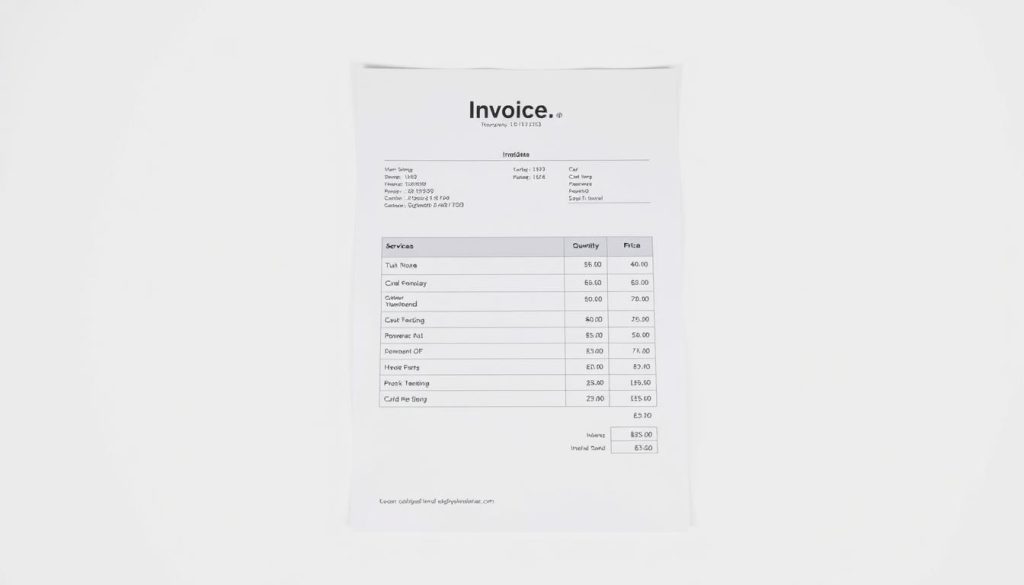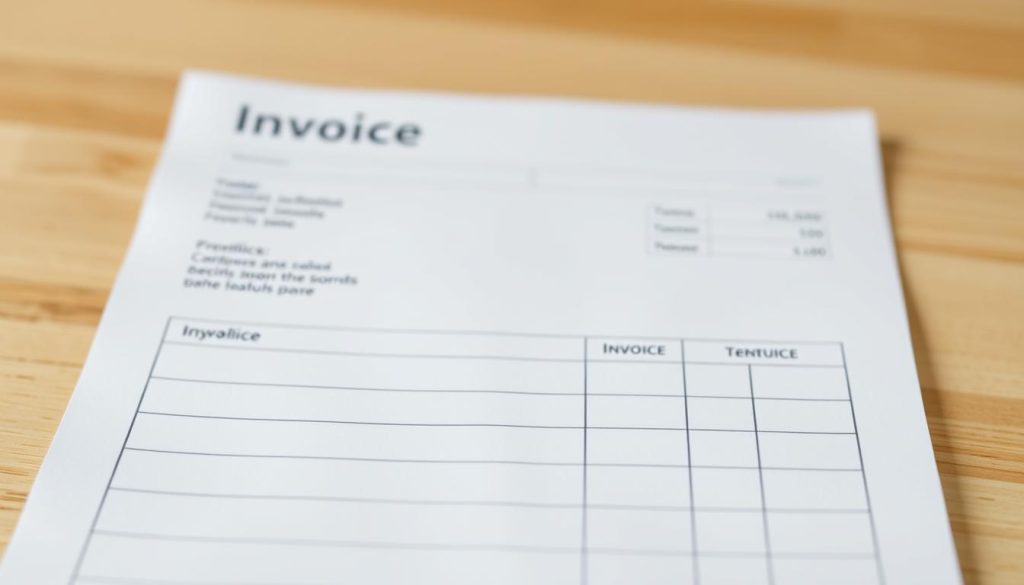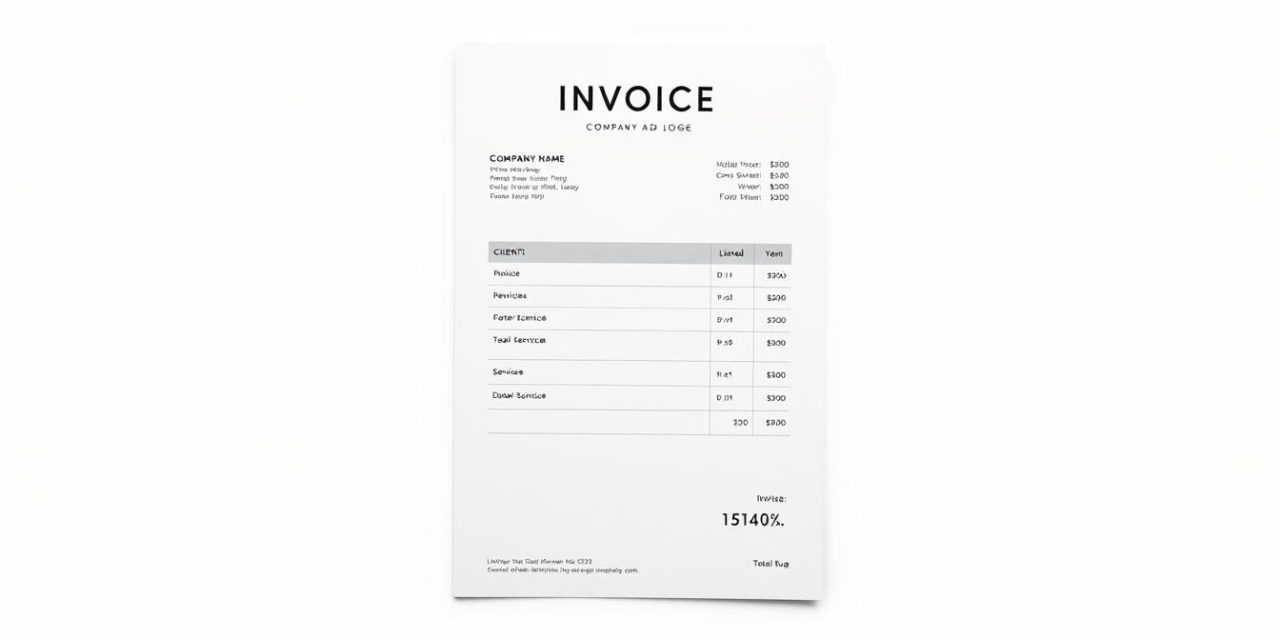Clear, accurate invoices make you look professional to clients and keep your business organized in France.
An invoice is the official record of a sale. It must include core information like dates, client details, itemized services, VAT status, and sequential numbering to meet Code de commerce L441-9. Missing elements can trigger fines and heavy administrative penalties.
Good invoices speed up payment, cut back-and-forth, and save time on repeat work. They also feed clean data into year-end taxes and bookkeeping, so your records stay ready for review.
Whether you use a simple spreadsheet, templates, or dedicated software, the right approach depends on volume and complexity. We will walk you through creation, numbering, dating, storage, and follow-up to avoid delays and errors.
For practical templates and best practices, see this guide on invoice templates and tools.
Table of Contents
Key Takeaways
- Issue accurate, legally compliant invoices under French law to avoid fines.
- Include essential information: dates, client data, amounts, and numbering.
- Clear invoices help speed up payment and reduce disputes with clients.
- Choose tools that match your workflow—templates for low volume, software for scaling.
- Keep copies and a revenue ledger for bookkeeping and tax reporting.
Why freelance invoicing matters in France right now
A clear invoice is often the single biggest lever to keep cash flowing when you juggle multiple clients and projects. About 74% of independent professionals face late payments, so simple steps—explicit due dates, itemized lines, and clear terms—cut risk fast.
In France, the standard is usually 30 days unless an agreement says otherwise. Stating the payment date and method reduces back-and-forth and prevents the common « we didn’t know » reply.
Professional formatting and branded details make you look organized and speed approval by accounts teams. Well-structured invoices also serve as official proof of income for tax filing and can be decisive evidence if a dispute reaches collections.
- Agree terms in writing before starting any contract to avoid confusion.
- Consistent billing habits cut admin time so you can focus on client work.
- Codify the process from agreement to delivery to billing to scale your business reliably.
French legal basics you must follow before you invoice
French commerce law sets clear triggers that require a formal invoice for a transaction. Always issue an invoice for B2B sales under Code de commerce L441-9. For B2C, a bill is required if the client asks, the fee exceeds €25, or the work concerns real estate.
When an invoice is mandatory
Obligatory cases: business-to-business sales, and specific consumer cases listed above. Missing an invoice can lead to heavy penalties.
Mandatory mentions to include
- Issue date and a unique invoice number.
- Your legal name, registered address, and SIREN/SIRET; add “Entrepreneur individuel” or “EI” if applicable.
- Client legal name and billing address.
- Clear description of the services, quantity/time, rate, and any discounts.
- Totals: pre-tax (HT), VAT rate and amount or “TVA non applicable, art. 293 B du CGI”, and total (TTC).
- Payment deadline, late penalties (ECB rate + 10 points) and the €40 recovery fee; include IBAN for transfers.
Special notes and risks
Errors or omissions can trigger fines per missing element and administrative penalties up to €75,000 for individuals. Save a client copy and your records. For templates and a detailed checklist, see our detailed guide.
How to create a professional invoice step by step
A tidy header and precise client details cut approval time and reduce questions.
Header and client info
Start with your business name, address, contact info and SIREN/SIRET. Add the client’s legal name and billing address so the invoice reaches the right person.
Include a clear Invoice label, a unique invoice number, and the issue date near the top.
Itemize the work
List each service with a short description, the quantity or time, and the unit rate. Show any discounts on separate lines so totals stay transparent.
Totals and taxes
Present the subtotal (HT), the VAT rate and amount, then the total due (TTC). If exempt, add TVA non applicable, art. 293 B du CGI.
Payment block
State the payment terms and the calendar due date (avoid vague phrasing). Add bank details with IBAN for transfers.
« Always double-check names, numbers and totals before you issue the invoice—small errors delay payments. »

| Section | What to include | Why it matters | Example |
|---|---|---|---|
| Header | Business name, SIREN/SIRET, client name | Fast routing to accounts | ACME SARL — Client SARL |
| Line items | Description, quantity, rate, discounts | Clarity on billed work | Web design — 10h @ €50 |
| Totals & payment | HT, VAT, TTC, due date, IBAN | Prevents disputes, speeds payments | Due 15/09/2025 — IBAN FR76… |
Legal mentions: note late penalty = ECB rate + 10 points and the €40 recovery fee so clients see consequences for late payments.
Numbering, dating, and storing invoices the right way
Clear numbering and accurate dates keep your billing tidy and audit-ready. A simple system saves time and avoids costly queries from tax authorities.
Consistent sequences and prefixes
Define a logical invoice sequence such as INV-2025-001 and never skip a number. Use prefixes to separate quotes and invoices (for example, QUO vs INV) so files are searchable.
Record the same invoice number on every copy. Periodic audits check for uninterrupted chronological sequences, so consistency matters.
Issue date vs. service date
Always show both the issue date and the service date when they differ. This helps clients book costs to the correct period and avoids disputes over payment timing.
Retention rules in France
Keep original and duplicate invoices for 10 years. Store documents in a secure, backed-up digital archive with standardized file names, such as INV-2025-004_ClientName_TTC.
| Topic | Rule | Why it matters | Example |
|---|---|---|---|
| Numbering | Unique, chronological | Audit transparency | INV-2025-012 |
| Dates | Issue date + service date | Correct accounting period | Issue: 01/07/2025 • Service: 30/06/2025 |
| Storage | 10 years, digital backup | Legal compliance | INV-2025-004_ClientName_TTC.pdf |
« A clean register with no gaps is your best defense in a review. »
Payment terms, late payments, and penalties that work
Set clear payment rules up front so cash stays predictable and disputes stay rare.
Choose payment terms that match your cash flow: Net 7 for fast work, Net 14/30 for standard cycles, or milestone schedules for longer projects.
For larger engagements, require a partial upfront deposit, staged payments, or a retainer to spread risk and secure commitment. New clients often need a deposit.
French late fees and recovery
State late payment penalties on every invoice: interest = ECB refinancing rate + 10 percentage points and a €40 flat recovery fee. This strengthens your position if a client delays.
Reduce risk with clear practices
- Show a firm due date and a short “payment due” line on each invoice.
- Send a friendly reminder a few days before the due date, then escalate politely if overdue.
- Offer early-payment discounts or automated links when clients have long internal cycles.
« Maintain a consistent policy across clients and log all reminders to support any later claims. »
| Option | When to use | Benefit |
|---|---|---|
| Net 7/14/30 | Small, repeat work | Predictable cash flow |
| Milestones | Long projects | Less credit risk |
| Upfront deposit | New clients or large scope | Commitment & security |
Tools and templates to streamline invoicing
Pick the right tool early: a simple invoice template can save time when you bill a few clients. Use a reusable template for low volume, single-currency work, and straightforward services.
When software makes sense
Switch to billing software as your volume, VAT complexity, or number of projects grows. Good platforms automate numbering, HT/TTC math, and legal mentions so you avoid manual errors.

Key software benefits
- Automation: automatic invoice numbers, correct VAT and totals.
- Saved client profiles, recurring invoices, and automated reminders cut admin time.
- Status tracking (sent, viewed, paid) — Qonto offers built-in tracking and branding options.
- Payment integrations speed payments and simplify reconciliation.
Public entities and data integrity
For public sector work, upload your PDF to Chorus Pro; the system converts it to an e-invoice and lets you track delivery. Keep a centralized library of templates per service type to preserve branding and required fields.
| Feature | Good for | Benefit |
|---|---|---|
| Template | Low volume | Fast setup |
| Software | High volume, VAT | Fewer errors |
| Chorus Pro | Public accounts | Mandatory e-delivery |
Pro tip: choose tools with secure access, backups, exportable reports for bookkeeping, and audit trails to prove delivery and changes. For practical examples, see our facturation clients guide.
Sending, tracking, and following up on invoices
Email your invoice as a PDF so formatting and numbers stay intact when accounts teams open it. Put the invoice number, total, and due date in the subject line and first sentence to make internal routing painless.
Include a one-line summary in the message body with the key details: invoice number, amount, and payment due. Ask the client to confirm receipt by reply or request a read receipt to ensure the document reached the right person.
Reminder timeline and tone
Send a friendly reminder a few days before the payment due date. Send a second notice on the due date and a firm follow-up one week later if needed.
Escalate carefully: start cordial, then reference agreed fees and potential next steps if late payments continue. Keep each message short and attach the PDF again.
Practical steps to track and resolve delays
- Log send times, replies, and any calls to the accounts contact so you can prove your timeline.
- Offer a secure payment link or repeat IBAN details to remove friction at payment time.
- If an invoice stalls, call the client’s accounts team to clarify missing information that may block payment.
« Simple subjects and a short summary cut processing time and reduce follow-up work. »
| Action | When | Benefit |
|---|---|---|
| Send PDF with summary | At issue | Preserves formatting; eases approval |
| Reminder 1 | Few days before due date | Prevents surprises |
| Reminder 2 | Due date | Prompts payment processing |
| Final follow-up | One week after due | References fees and next steps |
Project-based vs hourly invoicing: pricing, scope, and proof
Deciding between a fixed price and hourly rates shapes how you scope work and secure payment. A project fee gives certainty to the client; hourly billing ties pay to actual time spent. Choose the model that matches the project size and your cash needs.
Scoping, time tracking, and attaching records to invoices
For hourly work, keep a simple daily log or use a time-tracking tool. Attach a one-page summary to the invoice showing tasks, hours, and dates so the client can match charges to work.
For project fees, break the scope into milestones and use interim invoices to maintain cash flow and reduce risk. Always add start and end dates for the service period on the invoice.
Using estimates/proforma and signed agreements to prevent disputes
Proforma invoices act like estimates: they set expectations but are not legally binding. Convert an approved proforma into a final invoice after the client signs off.
- Signed estimate = contract: In France, a signed quote can serve as a binding agreement and strong proof if payment is disputed.
- Use clear line descriptions so clients can match each invoice line to agreed deliverables.
- Document change requests in writing and update scope, price, and payment terms accordingly.
« A clear agreement and simple proof of time cut disputes and speed payment. »
Conclusion
A tidy billing process protects your cash flow and keeps your business audit-ready.
Complete, compliant invoices help you get paid faster and shield your business in France. Make sure each document shows SIREN/SIRET, VAT or TVA non applicable, art. 293 B du CGI, clear due dates, and late-fee mentions (ECB +10 pts and €40).
Adopt a step-by-step routine: a reusable template, consistent numbering, service and issue dates, and secure 10-year storage. Use tools that automate VAT, totals, and reminders so you spend less time on paperwork and more on paid work.
For public contracts, send e-invoices via Chorus Pro. Review your current template today and align your account details and file names to make payments simpler for clients.
Need help? See our guide on freelance management for tools and tips that save time and reduce risk.
FAQ
What must I include on every invoice to comply with French law?
You must list your full business identity, the client’s name and address, a unique invoice number, the issue date, a clear description of services, amounts before tax (HT), VAT rate and amount, total including tax (TTC), payment terms, and your bank details or IBAN. For sole proprietors, include your SIREN/SIRET and any required EI notation.
When is issuing an invoice mandatory under the Code de commerce L441-9?
Under L441-9, an invoice is mandatory for any sale of goods or provision of services between professionals. You must also issue one when a client requests it or when payment is received for business activities. Keep a copy for the required retention period.
How should I number and date invoices to stay organized?
Use a consistent numbering sequence with prefixes if helpful (for example, 2025-001, 2025-002). Assign one unique number per invoice. Record both the issue date and, when different, the service or delivery date. This helps with accounting, VAT reporting, and audits.
What are safe payment terms to reduce late payments?
Choose clear terms like Net 7, Net 14, or Net 30 and state a precise payment due date. Offer milestone billing, retainers, or partial upfront payments for larger projects. Make late fees and recovery costs explicit on the invoice to deter delays.
What late penalties can I lawfully apply in France?
By contract or invoice you may charge interest at the ECB rate plus 10 percentage points for late payments. You can also claim a fixed €40 recovery fee for small debt collection costs when appropriate. State these terms clearly on your invoices.
How long must I keep copies of invoices in France?
French retention rules require keeping invoices and related accounting records for 10 years. Store originals or secure digital copies in an organized system so you can retrieve them for VAT checks or audits.
Should I use templates or billing software to create invoices?
Templates work well for simple, occasional billing. Use billing software when you need automation, VAT handling, recurring invoices, status tracking, or integration with accounting. Software speeds up reminders and reduces human error.
Do I need to send invoices in a specific format?
Send invoices as secure PDFs to preserve layout and prevent edits. Include a concise subject line and a short summary in the email body to highlight totals, due dates, and payment instructions. Keep records of sent emails and delivery confirmations.
What’s the best way to follow up on overdue payments?
Start with a polite reminder shortly after the due date. Follow with progressively firmer messages: a second reminder, a formal notice including late fees, then a registered letter or debt recovery if needed. Maintain a clear timeline and documentation.
How do I invoice project-based work versus hourly work?
For project-based work, attach the agreed scope, deliverables, and milestone schedule to the invoice. For hourly work, itemize time entries with dates, hours, and rates. Use estimates or proforma invoices and signed agreements to prevent disputes.
How should I show VAT and totals on the invoice?
Break out amounts as subtotal HT (before tax), list the VAT rate and VAT amount per line or in a VAT summary, then show the TTC total. If a supply is VAT-exempt, cite the legal basis or mention “TVA non applicable” with the relevant article.
Can I use electronic invoicing for public sector clients in France?
Yes. Invoices to public entities must be sent via Chorus Pro. The platform handles receipt and tracking. Ensure your electronic invoices meet format and data requirements to avoid rejection or payment delays.
What bank details and payment methods should I include?
Provide your full bank name, IBAN, and BIC/SWIFT for transfers. Offer multiple payment options if possible: bank transfer, SEPA, or payment platforms. State clear instructions for where and how clients should make payments.
How do I handle discounts, refunds, and credits on invoices?
Apply discounts as separate line items with a clear description and amount. Issue credit notes for refunds or corrections, referencing the original invoice number. Keep both documents linked in your records for VAT and accounting reconciliation.
What information reduces the risk of invoice disputes?
Include a concise scope of work, dates of service, time logs or deliverables when relevant, contract references, and contact details for queries. Attach signed estimates or agreements to support billing and speed resolution of disagreements.





